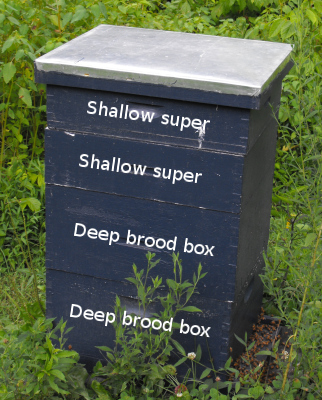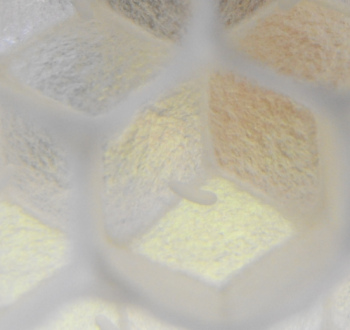
Easiest way to split a hive
 Now
that you've slogged through two days of bee doom and gloom, it's time
for a new hope --- splitting your hive in two! I've been daunted
by the notion of hive splitting in the past, since the techniques for
optimal efficiency are
complicated and often require special equipment. But there are
also quick and dirty techniques that work quite well using standard
hive boxes if you only want to create one new hive from each of your
hives rather than turning one hive into as many colonies as possible.
Now
that you've slogged through two days of bee doom and gloom, it's time
for a new hope --- splitting your hive in two! I've been daunted
by the notion of hive splitting in the past, since the techniques for
optimal efficiency are
complicated and often require special equipment. But there are
also quick and dirty techniques that work quite well using standard
hive boxes if you only want to create one new hive from each of your
hives rather than turning one hive into as many colonies as possible.
The simplest way to
split a hive is to begin with double deeps and wait
until both deep boxes are full of brood, honey, and pollen. You
should have a mixture of fresh eggs, uncapped brood, and capped brood
in each box --- if not, swap some around so the two boxes are evenly
filled with brood. Then set up a bottom board in a new
location and carry one of the deep brood boxes over to place on
it. Shake some extra nurse bees into the box, put on the inner
and outer cover, add an entrance reducer, and you're done.
 One of the split hives will
have the queen in it --- this is the mother
colony --- while the other will realize they are queenless and will
quickly turn one of the eggs into a queen. Within a few days, you
should be able to tell the difference in the hives. Treat the
mother
colony the way you would any other hive, but leave the nucleus (aka
"nuc" --- the hive with no queen) alone for 30 days to let them raise a
queen and give her time to start laying.
One of the split hives will
have the queen in it --- this is the mother
colony --- while the other will realize they are queenless and will
quickly turn one of the eggs into a queen. Within a few days, you
should be able to tell the difference in the hives. Treat the
mother
colony the way you would any other hive, but leave the nucleus (aka
"nuc" --- the hive with no queen) alone for 30 days to let them raise a
queen and give her time to start laying.
Inevitably, most of the
foraging bees will drift back to the hive in
the old location, which is why you put some extra bees in the hive you
carted to a new spot. This is also why you want to make sure both
hives have at least a few frames of pollen and honey to get them
started while they regroup and get back on track.
As long as you carry out
your split early in the year --- I figure April or May in our area ---
you shouldn't have to give either hive supplemental feed. You
won't get as much honey that year as you would have without performing
the split, but you will probably be able to harvest at least a bit of
honey from the mother hive (and maybe from the nuc as well.) I've
decided to try this out with both of our hives, if they seem strong
enough, and hope that we'll end 2011 with four hives instead of two.
| This post is part of our Natural Beekeeping lunchtime series.
Read all of the entries: |
Want more in-depth information? Browse through our books.
Or explore more posts by date or by subject.
About us: Anna Hess and Mark Hamilton spent over a decade living self-sufficiently in the mountains of Virginia before moving north to start over from scratch in the foothills of Ohio. They've experimented with permaculture, no-till gardening, trailersteading, home-based microbusinesses and much more, writing about their adventures in both blogs and books.
Want to be notified when new comments are posted on this page? Click on the RSS button after you add a comment to subscribe to the comment feed, or simply check the box beside "email replies to me" while writing your comment.
 With luck we are hoping to split all three of our hives in the spring (we also obtained a swarm this year, it gave us 14 pounds of honey) so that we finish the year with 6 hives (or 8 if we can also collect a couple of swarms). Our goal is 10 and then begin selling our splits to new beekeepers. We try to promote responsible beekeeping whenever possible as well as healthy, year-round plantings for the bees. Thank you for the information regarding varroa mites ... we just found we had some (we are bad and haven't been checking!) and will try the black walnut smoke as that seems the least invasive and we have plenty of leaves here with several trees on our farm. Looking forward to reading more on your blog!
With luck we are hoping to split all three of our hives in the spring (we also obtained a swarm this year, it gave us 14 pounds of honey) so that we finish the year with 6 hives (or 8 if we can also collect a couple of swarms). Our goal is 10 and then begin selling our splits to new beekeepers. We try to promote responsible beekeeping whenever possible as well as healthy, year-round plantings for the bees. Thank you for the information regarding varroa mites ... we just found we had some (we are bad and haven't been checking!) and will try the black walnut smoke as that seems the least invasive and we have plenty of leaves here with several trees on our farm. Looking forward to reading more on your blog!
- Remove comment
